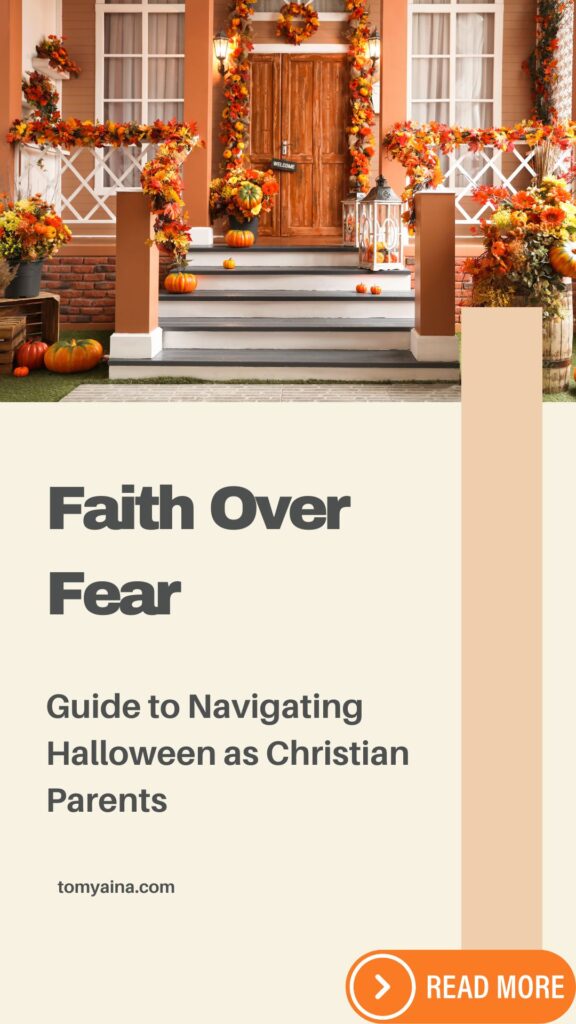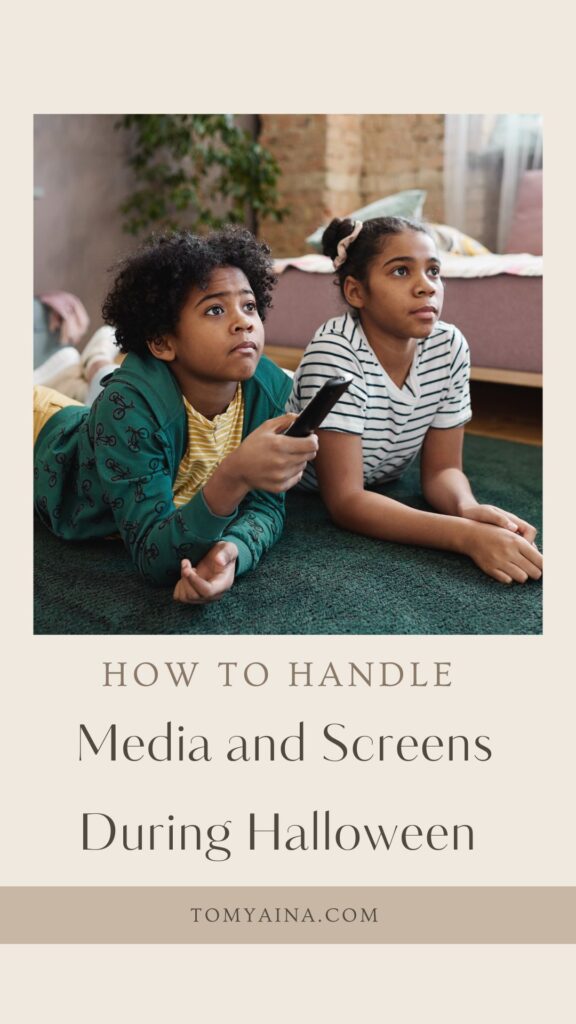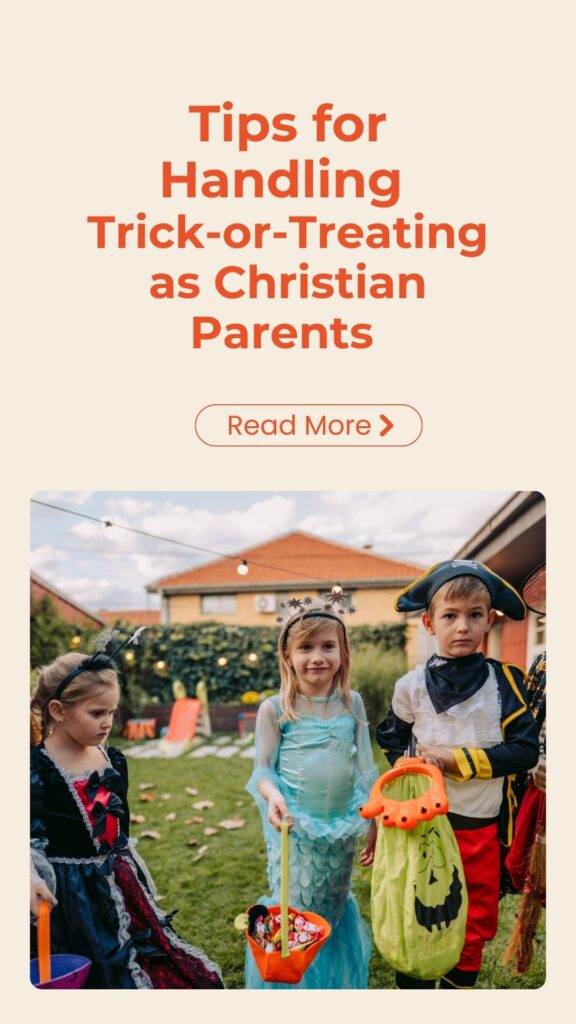Every year as Halloween approaches, Christian parents face the same important question: Should Christians celebrate Halloween?

I’m not here to argue about pagan origins, Catholic Church history, or whether October 31st is a pagan holiday or a saint’s day. This post isn’t about winning a debate.
My goal is to give Christian families some biblical principles and practical ways to prepare our kids for this time of year. Because if all we say is “We don’t celebrate Halloween,” that may not be enough for a young child with lots of questions.
Instead, let’s use this particular day as a perfect opportunity to point our kids to the Lord Jesus with courage and joy, using the Holy Spirit’s wisdom.
Costumes and Decorations
In my neighborhood, some families spend weeks putting up Halloween displays. Giant skeletons, grim reapers on porches, glowing ghosts in the yard. Even as an adult it can feel unsettling. For kids, it is often their first real encounter with scary things.

This is a good teaching moment to share a memory verse:
“God has not given us a spirit of fear, but of power and of love and of a sound mind.” (2 Timothy 1:7)
Remind your children that skeletons, ghosts, and decorations have no power compared to God. Fear and darkness cannot stand against Jesus.
You can also connect it to a Bible story. David and Goliath is a favorite with toddlers. Goliath looked frightening, but David stood firm because his faith was in God. Just like David, kids can be brave knowing God is with them.
Parent Tip: If your child wears a costume, use Philippians 4:8 as a guide. Encourage choices that are noble, pure, and admirable.
- A princess like Esther (noble)
- A shepherd like David (pure-hearted)
- A firefighter (admirable)
Help them reflect light instead of fear.
Media and Shows
Some weeks before Halloween, even family-friendly shows start turning spooky. Cartoons add ghosts, witches, or dark themes, and kids may feel curious—or even pressured—to watch.

Here is a way we can handle this:
Step 1: Gently Encourage
Talk with your kids ahead of time and gently encourage them to skip spooky shows, especially if your family doesn’t practice Halloween.
Step 2: Teach a Memory Verse
Ground the conversation in God’s Word:
“Whatever is true, whatever is noble, whatever is right, whatever is pure, whatever is lovely, whatever is admirable—think about such things.” (Philippians 4:8)
This reminds children that what they watch matters—and that God calls us to focus on good things.
Step 3: Use a Mini-Script
Here’s a simple script you can use as a guide:
- “Sometimes shows add scary things for Halloween, but we know they have no power. Jesus is stronger than all of it.”
- “In our family, we don’t fill our minds with scary stuff. We choose what makes us brave, kind, and joyful.”
- “If you see something spooky, come to me—we’ll find something better together.”
Parent Tip: Give your kids fun alternatives—like fall-themed storybooks, kid-friendly movies, or family game nights—so they don’t feel left out
School Parties and Activities
In many elementary schools and daycares, Halloween brings themed storybooks, costume parades, and classroom parties. Some programs even encourage kids to dress up or bring treats. This can feel tricky for Christian families, especially if you want to handle it with both conviction and grace.

Here is a way we can handle this:
Step 1: Start the Conversation Early
If you don’t want your child participating, explain why ahead of time in age-appropriate language. This helps them feel prepared instead of surprised or left out.
Step 2: Share a Family Memory Verse
“Do not be afraid, for I am with you; do not be dismayed, for I am your God.” (Isaiah 41:10)
This reassures kids that even if they feel different, they’re never alone—God is with them.
Step 3: Talk About Books and Stories
Most schools read seasonal books in October, many of them with Halloween themes. You don’t have to over-flog it, but keep pointing your kids back to this truth: those things have no power compared to Jesus. A simple reminder like, “That’s just pretend, but God is real and stronger,” can anchor them.
Step 4: Give Them Simple Talking Points
Equip your child with gentle answers for classmates who may ask questions:
- “My family doesn’t do Halloween, but we still have fun at home.”
- “I’m not wearing a costume, but I’m still excited for the day.”
Step 5: Debrief After School
When they come home, ask how the day went and how they felt. This keeps the conversation ongoing and helps them process any emotions.
Parent Tip:
- If you allow costumes → return to the Costumes and Decorations guide and help them pick something noble, pure, and admirable.
- If you don’t → plan a fun alternative at home (treats, games, or family time) so your child doesn’t feel left out.
Trick-or-Treating and Community
For many families, Halloween really comes down to one thing: candy. Whether or not your Christian family participates, there are still ways to make it meaningful and keep the focus on faith.

Here is a way we can handle this:
Step 1: If You Go Out
Pray together before leaving the house. Remind your kids that Jesus is with them wherever they go. You can also encourage them to be kind and respectful at each home they visit.
Step 2: If You Stay In
Hand out candy with Bible verses or gospel tracts. Another simple idea is to place a bowl of candy outside your door with a note that says “God loves you.” It’s a small way to share light in your neighborhood.
Step 3: If You Skip It Altogether
Plan an alternative at home. Some families host a harvest party, fall festival, or family game night. You can even take your kids candy shopping so they don’t miss the fun. If your church holds an event, that’s also a great way to build community in a faith-filled space.
Step 4: Add a Sweet Touch
One more idea is to set up a jar of sweets at home. That way, even if your kids don’t go door-to-door, they still enjoy a little treat tradition.
Parent Tip: Trick-or-treating doesn’t have to be about fear or darkness. Whether you go out, stay in, or skip it, focus on kindness, community, and pointing your kids back to the goodness of God.
Final Thoughts
This is not about saying yes or no to Halloween. It is about having ongoing conversations with our kids about fear, faith, and following Christ.
In my home, my son already points out Halloween shows and says, “We don’t watch that.” He has even corrected a show my husband was watching because it looked spooky. That is not because we are perfect, but because conviction has become part of our family culture.
The truth is, scary things have no power. Jesus is stronger. And when kids hear that again and again, they begin to believe it for themselves.
Rules do not shape hearts, the Holy Spirit does. Our role as parents is to guide, but it is the Spirit who convinces.
So start the conversation now, not on October 31. Talk about costumes, media, school events, and candy. Use Bible verses, stories, and small alternatives to prepare their hearts.
Halloween is one day. But walking our children through it with truth and courage helps build a faith that lasts a lifetime.

Leave a Reply